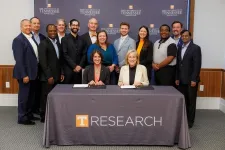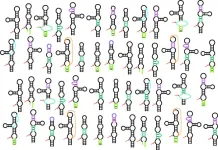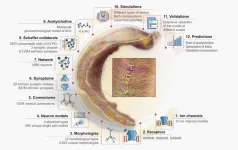(Press-News.org) A tightly tied waist cord of the underskirt (petticoat) traditionally worn under a saree, particularly in rural parts of India, may lead to what has been dubbed ‘petticoat cancer,’ warn doctors in the journal BMJ Case Reports after treating two women with this type of malignancy.
The continued pressure and friction on the skin can cause chronic inflammation, leading to ulceration, and, in some cases, progression to skin cancer, say the authors.
This phenomenon has previously been described as “saree cancer,” but it is the tightness of the waist cord that’s to blame, they point out.
The first case concerned a 70 year old woman who sought medical help because of a painful skin ulcer on her right flank that she had had for 18 months and which wouldn’t heal. The skin in the surrounding area had lost its pigmentation. She wore her petticoat underneath her saree which was tightly tied around her waist.
A biopsy specimen revealed that she had a Marjolin ulcer, also known as squamous cell carcinoma (ulcerating skin cancer).
The second case concerned a woman in her late 60s who had had an ulcer on her right flank that wouldn’t heal for 2 years. She had worn a traditional type of saree called a ‘lugda’ every day for 40 years, tied very tightly around the waist without an underskirt.
A biopsy specimen revealed that she too had a Marjolin ulcer. The cancer had already spread to one of the lymph nodes in her groin when she was diagnosed.
A Marjolin ulcer is rare but aggressive. It develops in chronic burn wounds, non-healing wounds, leg ulcers, tuberculous skin nodules, and in vaccination and snake bite scars, explain the authors.
“The exact process by which chronic ulcers or wounds become malignant is unknown, although many theories have been proposed,” they write. “Every cutaneous lesion that is continuously irritated (chronically inflamed) has been shown to have a higher risk of developing malignant transformation.”
They add: “Constant pressure at the waist often leads to cutaneous atrophy, which ultimately breaks down to form an erosion or an ulcer. The ulcer at this site does not heal entirely due to ongoing pressure from tight clothing. A chronic non-healing wound results, which may develop malignant change.”
They recommend wearing a loose petticoat beneath the saree to ease pressure on the skin, and to wear loose clothing if skin problems develop to allow the area to heal.
Commenting on her diagnosis, the 70 year old said: “I have been wearing a Nauvari saree, tightly wrapped around my waist, for most of my adult life. Six years ago, I noticed a small area of depigmentation on my right flank, which I initially dismissed as a minor skin issue.
“Over time, this spot turned into a non-healing ulcer, causing me concern and discomfort. The discomfort became a part of my daily life, impacting my ability to perform routine tasks. When I finally consulted a dermatologist, I was diagnosed with skin cancer, mostly exacerbated by the chronic friction and pressure from the tightness of the saree tied around my waist.
“This has been a psychologically and physically taxing journey. It shows the importance of paying attention to chronic skin changes and seeking medical advice early. I hope my story will raise awareness among women about the potential health risks associated with traditional clothing practices and encourage timely medical consultation for unusual skin conditions.”
END
Tightly tied waist cord of saree underskirt may pose cancer risk, warn doctors
Continued cord friction linked to chronic inflammation, leading to skin ulceration
2024-11-06
ELSE PRESS RELEASES FROM THIS DATE:
10% of children in high-burden tuberculosis settings may develop the disease by age 10
2024-11-06
EMBARGOED UNTIL 6:30 PM EST Tuesday, November 5, 2024
Contact:
Jillian McKoy, jpmckoy@bu.edu
Michael Saunders, msaunder@bu.edu
##
10% of Children in High-Burden Tuberculosis Settings May Develop the Disease by Age 10
New findings also indicate that children who live in settings with a high burden of TB have a consistently high annual risk of developing TB infection throughout childhood.
An estimated 1.2 million children develop tuberculosis disease (TB) and 200,000 kids die from TB worldwide each year, but the risk of developing TB infection and disease throughout childhood remains under-studied. Furthermore, the majority of studies on the pediatric burden of TB are informed by data ...
Health experts push for the elimination of a ‘remarkably harmful toxin’
2024-11-06
The Biden administration’s recently announced plan to replace all lead pipes in the U.S. is a reminder that the toxic metal remains a threat, even in a country that has largely banned its use. The smallest levels of lead exposure can cause a range of health damages over time, especially to children’s brain development. Stanford researchers Stephen Luby and Jenna Forsyth have spent years examining the widespread presence of lead in low-income countries, including in some commonly consumed products. They led a perspective published Nov. 5 in The Lancet Public Health that tallies lead’s global ...
University of Tennessee, Lockheed Martin expand Master Research Agreement
2024-11-05
The University of Tennessee, Knoxville, and defense technology company Lockheed Martin announced the signing of a new five-year master research agreement Oct. 31, reinforcing a longstanding partnership that helps UT take its research capabilities from the lab to the field.
“This partnership allows UT researchers to conduct true translational research,” said James Andes, director of national security research initiatives for UT. “Our research concepts are matured by working with technical champions at Lockheed Martin, and as a ...
Testing thousands of RNA enzymes helps find first ‘twister ribozyme’ in mammals
2024-11-05
UNIVERSITY PARK, Pa. — The “RNA world” hypothesis proposes that the earliest life on Earth may have been based on RNA — a single-stranded molecule similar in many ways to DNA — like some modern viruses. This is because, like DNA, RNA can carry genetic information, but, like a protein, it can also act as an enzyme, initiating or accelerating reactions. While the activity of a few RNA enzymes — called ribozymes — have been tested on a case-by-case basis, there are thousands more that have been computationally predicted to exist in organisms ranging from bacteria to plants and animals. Now, ...
Groundbreaking study provides new evidence of when Earth was slushy
2024-11-05
At the end of the last global ice age, the deep-frozen Earth reached a built-in limit of climate change and thawed into a slushy planet.
Results from a Virginia Tech-led study provide the first direct geochemical evidence of the slushy planet — otherwise known as the “plumeworld ocean” era — when sky-high carbon dioxide levels forced the frozen Earth into a massive, rapid melting period.
“Our results have important implications for understanding how Earth's climate and ocean chemistry changed after the extreme conditions of the last global ...
International survey of more than 1600 biomedical researchers on the perceived causes of irreproducibility of research results
2024-11-05
International survey of more than 1600 biomedical researchers on the perceived causes of irreproducibility of research results
#####
In your coverage, please use this URL to provide access to the freely available paper in PLOS Biology: http://journals.plos.org/plosbiology/article?id=10.1371/journal.pbio.3002870
Article Title: Biomedical researchers’ perspectives on the reproducibility of research
Author Countries: Canada, Australia, United States
Funding: The author(s) received no specific funding for this work. END ...
Integrating data from different experimental approaches into one model is challenging – this study presents a community-based, full-scale in silico model of the rat hippocampal CA1 region that integra
2024-11-05
Integrating data from different experimental approaches into one model is challenging – this study presents a community-based, full-scale in silico model of the rat hippocampal CA1 region that integrates diverse experimental data from synapse to network
#####
In your coverage, please use this URL to provide access to the freely available paper in PLOS Biology: http://journals.plos.org/plosbiology/article?id=10.1371/journal.pbio.3002861
Article Title: Community-based reconstruction ...
SwRI awarded grant to characterize Las Moras Springs watershed
2024-11-05
SAN ANTONIO — November 5, 2024 — Hydrologists at Southwest Research Institute (SwRI) will begin a 12-month targeted water-sampling campaign of the Las Moras Springs system near Brackettville, Texas. The project will analyze and characterize the system of springs and their relationship to the Pinto Creek watershed to improve water management and conservation efforts.
“Las Moras, like many other Texas spring systems, are at-risk and prone to going dry. It is important to clear up uncertainties about their source and relationship with ...
Water overuse in MATOPIBA could mean failure to meet up to 40% of local demand for crop irrigation
2024-11-05
Considered one of the fastest-growing agricultural frontiers in Brazil, and the area with the highest greenhouse gas emissions in the Cerrado, Brazil’s savanna-type biome, the region known as MATOPIBA risks facing water shortages in the years ahead. Water overuse may mean that between 30% and 40% of demand for crop irrigation cannot be met in the period 2025-40. MATOPIBA is a portmanteau of the names of four states – Maranhão, Tocantins, Piauí, and Bahia (all but Tocantins located in Brazil’s Northeast ...
An extra year of education does not protect against brain aging
2024-11-05
Thanks to a 'natural experiment' involving 30,000 people, researchers at Radboud university medical center were able to determine very precisely what an extra year of education does to the brain in the long term. To their surprise, they found no effect on brain structure and no protective benefit of additional education against brain aging.
It is well-known that education has many positive effects. People who spend more time in school are generally healthier, smarter, and have better jobs and higher incomes than those with less education. However, whether prolonged education actually causes changes in brain structure over the long term ...
LAST 30 PRESS RELEASES:
Next-generation vision model maps tree growth at sub-meter precision
Genes aren’t destiny for inherited blindness, study shows
MIT study: High-fat diets make liver cells more likely to become cancerous
Exposure to multiple fine particulate matter components and incident depression in the US Medicare population
Risk of burdensome health care spending over time in the US
Nirsevimab against hospitalizations and emergency department visits for lower respiratory tract infection in infants
New microfluidics technology enables highly uniform DNA condensate formation
A new strategy for immune tolerance
Super Mario Bros. help fight burnout: New study links classic games to boosted happiness
Deepest gas hydrate cold seep ever discovered in the arctic: International research team unveils Freya Hydrate Mounds at 3,640 m depth.
Integrating light and structure: Smarter mapping for fragile wetland ecosystems
ACA-SIM: A robust way to decode satellite signals over complex waters
Probiotics can restore gut microbiome in breastfed infants
AI could help predict nutrition risks in ICU patients, study finds
Federal EITC has unexpected result, researchers say – it decreases domestic violence
Researchers identify gene that calms the mind and improves attention in mice
Artificial metabolism turns waste CO2 into useful chemicals
Ancient sea anemone sheds light on animal cell type evolution
Begging gene leads to drone food
How climate policies that incentivize and penalize can drive the clean energy transition
Can community awareness campaigns in low-resource areas improve early diagnosis of colorectal cancer?
Stardust study resets how life’s atoms spread through space
Practical education: Clinical scenario-based program development
The impact of family dynamics on eating behaviour – how going home for Christmas can change how you eat
Tracing the quick synthesis of an industrially important catalyst
New software sheds light on cancer’s hidden genetic networks
UT Health San Antonio awarded $3 million in CPRIT grants to bolster cancer research and prevention efforts in South Texas
Third symposium spotlights global challenge of new contaminants in China’s fight against pollution
From straw to soil harmony: International team reveals how biochar supercharges carbon-smart farming
Myeloma: How AI is redrawing the map of cancer care
[Press-News.org] Tightly tied waist cord of saree underskirt may pose cancer risk, warn doctorsContinued cord friction linked to chronic inflammation, leading to skin ulceration




